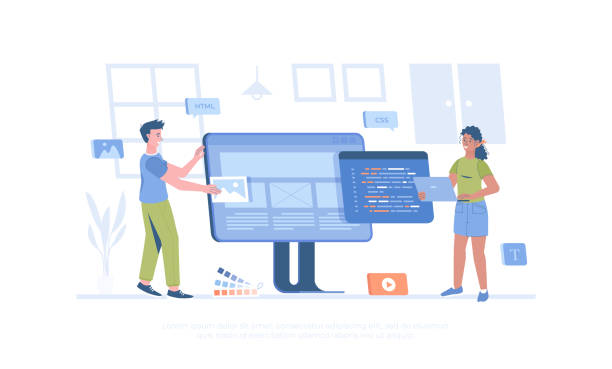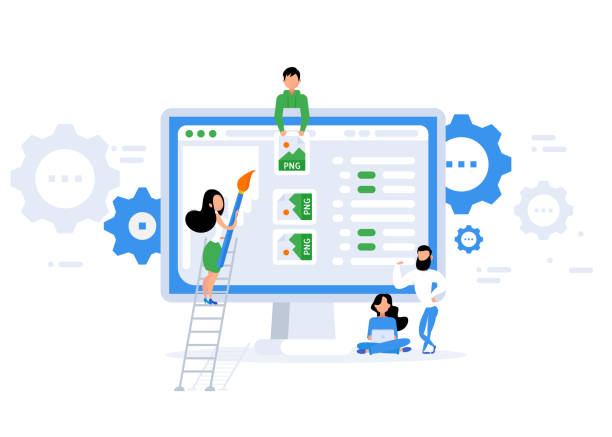An Introduction to Multilingual Website Design and Its Importance

In today’s world, where geographical boundaries have become meaningless in the digital space, #multilingual_website_design is no longer considered an advantage, but a necessity.
This strategic move allows businesses to reach a wider audience beyond their linguistic and cultural boundaries.
Single-language websites miss out on a significant portion of potential global markets.
By providing content in different languages, you not only increase access to information for users, but also establish deeper trust and connection with them.
This is especially crucial for companies looking to export goods or services.
Imagine you have a unique product but your website is only in Persian; how can you attract German, Chinese, or Spanish customers? Designing a multilingual platform is a gateway to international markets and helps you to conduct your global marketing more effectively.
This process is not merely limited to content translation but includes full localization for each geographical region to ensure a completely relevant and engaging user experience.
A multilingual website helps you to strengthen your brand globally and be recognized as a reliable authority in your industry.
The importance of this approach becomes more evident, especially in an era of increased global competition, compelling businesses to adopt innovative solutions for achieving success.
Are you frustrated with your online store’s low conversion rate?
Rasaweb, with its professional e-commerce website design, is your definitive solution!
✅ Increase your sales and revenue
✅ Provide an unparalleled user experience for your customers
⚡ Get a free consultation now!
Competitive Advantages of Multilingual Websites

Implementing a #multilingual_website not only opens new horizons for businesses but also brings significant competitive advantages.
One of the most important advantages is improved search engine rankings (SEO).
By creating content in various languages, your website will have a greater chance of appearing in search results for users worldwide.
This translates to increased organic and targeted traffic, which directly leads to higher sales and revenue.
Furthermore, multilingual websites build greater credibility and trust among international audiences.
When users find content in their native language, they feel a stronger connection and comfort with your brand.
This is particularly important for service industries and online sales.
Moreover, with the increasing spread of the internet in various countries, having a multilingual website positions you as a market leader.
Many of your competitors may not have yet reached this level of globalization, and this is a golden opportunity for you to capture a larger market share.
Internet access is increasing, and a huge population of non-English speaking users are searching for information and products.
Multilingual website design allows you to target this vast population.
Finally, improved user experience is another key advantage.
Users prefer to interact with a platform that respects their linguistic and cultural needs, which significantly helps increase conversion rates and customer loyalty.
This strategy demonstrates a business’s long-term vision for global growth and development.
Key Challenges in Implementing a Multilingual Website Design Project

Successful implementation of a #multilingual_website_design project, despite its numerous benefits, comes with several challenges that require precise and specialized planning.
The first challenge relates to content management and ensuring the accuracy and quality of translations.
Simply translating words is not enough; content must be localized to align with the culture and linguistic sensitivities of each region.
This includes idioms, units of measurement, dates, and even images.
The second challenge involves technical issues related to URL structure and hreflang tags, which are crucial for multilingual SEO.
Improper implementation of these can lead to serious problems in website ranking on search engines.
Furthermore, choosing the right Content Management System (CMS) that adequately supports multilingualism is a key decision.
Some CMS platforms have multilingual capabilities by default, while others require complex plugins and configurations.
Managing the translation process and ensuring simultaneous content updates across all languages is also an important operational challenge.
The translation team must work closely with SEO specialists and website developers to ensure synchronization and optimal quality.
Finally, precise budgeting and scheduling for each language and localization process are other challenges that must be managed carefully.
These challenges require expertise and experience to overcome them, resulting in a high-quality, optimally performing multilingual website.
Comparison of Content Translation Approaches
| Translation Approach | Advantages | Disadvantages | Output Quality | Speed | Approximate Cost |
|---|---|---|---|---|---|
| Human Translation (Native Speaker) | Highest quality, deep localization, cultural understanding | Time-consuming, costly | Excellent | Low | High |
| Machine Translation (MT) | High speed, low cost, large volume | Low accuracy, lack of cultural understanding, unnatural sentences | Medium to Low | High | Low |
| Machine Translation with Human Editing (PEMT) | Good balance between speed, cost, and quality | Still does not reach human translation quality | Good | Medium | Medium |
| Use of Translation Management Systems (TMS) | Easy management of high volume translation, translation memory, repetition reduction | Requires training, initial software cost | Variable (depends on input) | Medium to High | Medium to High |
Choosing the Right Platform for Multilingual Website Design

One of the pivotal decisions in #multilingual_website_design is choosing the right platform (CMS).
This choice will directly impact the ease of content management, development flexibility, and SEO performance of your website.
Various platforms exist, each with its own advantages and disadvantages for supporting multilingual capabilities.
For instance, WordPress, with plugins like WPML or Polylang, is one of the most popular options for multilingual sites, highly suitable for small and medium-sized businesses.
These plugins enable the translation of posts, pages, categories, and even menus.
In contrast, platforms like Drupal or Joomla offer more robust and native multilingual capabilities, making them suitable for larger, more complex projects with high customization needs.
The platform selection should be based on specific project requirements, budget, the technical level of the team, and the long-term goals of the website.
Some companies might even opt for custom solutions or use “Headless CMS” which offer greater flexibility in delivering content in different languages across various platforms (web, mobile, smart devices).
It is important that the chosen platform is scalable to allow for adding new languages and managing a larger volume of content as the business grows.
This initial decision forms the backbone of your multilingual website’s success and impacts its future development and maintenance.
Did you know that 94% of the first impressions of a company are related to its website design?
Rasaweb, by offering professional corporate website design services, helps you create the best first impression.
✅ Create a professional and trustworthy image for your brand
✅ Easily attract potential customers and improve your online presence
⚡ Get a free corporate website design consultation
Content Strategy and Localization in Multilingual Websites

Simply translating content into different languages is only part of the #multilingual_website_design puzzle.
To achieve true effectiveness, a comprehensive and localization-based content strategy must be adopted.
Localization goes beyond word-for-word translation; this process involves adapting content to the cultural, social, political, and even legal aspects of a specific region.
For example, a marketing campaign that performs well in Iran might be completely ineffective in Japan or Germany due to cultural differences.
Therefore, for each target market, unique content, or at least a localized version of the original content, should be created.
This includes changing images, colors, tone of voice, examples, and even storytelling to resonate with local audiences.
Localization also means understanding industry-specific terminology and keywords used in each language and region.
The content team must collaborate with native language specialists to ensure the accuracy and cultural/linguistic appropriateness of the content.
This approach is extremely important for digital marketing and SEO.
Ignoring localization can lead to misunderstandings, unintentional offense, and ultimately, loss of audience trust.
Therefore, every step in creating content for multilingual sites must be taken with the specific characteristics of each target market in mind, aiming to create a fully personalized user experience.
This strategy guarantees your long-term success in international markets.
Search Engine Optimization (SEO) for Multilingual Websites
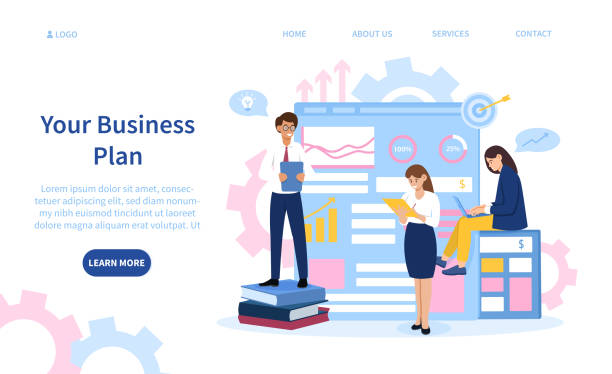
Search Engine Optimization (SEO) for a multilingual website has its own complexities that go beyond single-language website SEO.
In #multilingual_website_design, it is necessary to formulate SEO strategies for each language and geographical region separately and targeted.
One of the most important aspects is the correct use of hreflang tags.
These tags help search engines like Google to display the correct language version of your website to users in different geographical regions.
Lack of use or incorrect use of these tags can lead to duplicate content issues and reduced rankings.
URL structure is also very important in multilingual SEO.
There are various options, including top-level domains (TLDs) for each country (e.g., .de for Germany), subdomains (e.g., de.example.com), or subfolders (e.g., example.com/de/), each having its own SEO advantages and disadvantages.
The selection of the appropriate URL structure must be done carefully.
Keyword research for each language is also essential, as highly searched keywords in one language may not have an exact equivalent in another language or may be associated with a different search intent.
Furthermore, local link building and registering the website in local directories can help improve regional SEO.
Finally, monitoring SEO performance in each language and making necessary adjustments for continuous improvement is an integral part of managing a successful multilingual website.
This approach ensures that your site is well-visible in all markets and attracts targeted traffic.
Translation Management and Quality Assurance in Multilingual Website Design
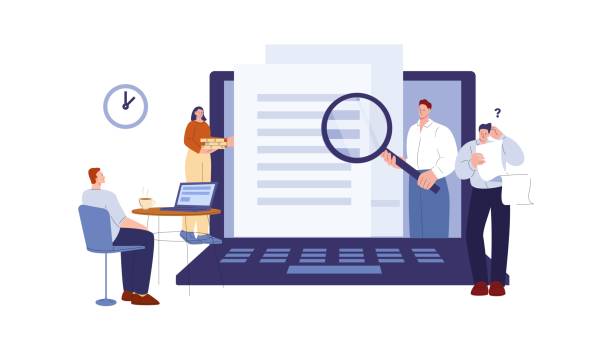
The success of a #multilingual_website_design is highly dependent on #translation_quality and its management process.
Regardless of the tools used, ensuring the quality of translated content is vital for maintaining brand credibility and providing an optimal user experience.
This process includes several stages: selecting experienced and native-speaking translators, using Translation Management Systems (TMS) that help maintain terminology consistency and accelerate the process, and conducting thorough reviews by independent editors.
Tools such as Translation Memories and Term Bases play a significant role in reducing costs and increasing translation speed, as they prevent re-translation of repeated phrases.
After the translation phase, the review and Quality Assurance (QA) stage gains double importance.
This stage includes checking content for grammatical accuracy, spelling, style, and cultural appropriateness.
It is best for this review to be conducted by another native translator who offers a fresh perspective.
Also, testing the website in different languages, including checking the correct display of texts (right-to-left or left-to-right), fonts, and formatting, is essential.
Ensuring that all website elements, including buttons, forms, and error messages, are correctly translated and localized can prevent major user experience problems.
An efficient translation management system not only facilitates the process but also ensures consistency and uniformity of content across all languages.
This comprehensive approach is the cornerstone of a reliable and effective multilingual website.
Multilingual Content Quality Assurance Checklist
| Item | Description | Responsible | Status |
|---|---|---|---|
| Translation Accuracy | Does the translation match the original meaning and contain no errors? | Second translator / Editor | Completed / Needs review |
| Cultural Localization | Is the content culturally appropriate (images, idioms, examples)? | Localization specialist | Completed / Needs review |
| Grammar and Spelling | Is the text free of grammatical and spelling errors? | Editor | Completed / Needs review |
| Terminology Consistency | Are specialized vocabulary and key terms translated consistently across the site? | Project Manager / TMS | Completed / Needs review |
| Formatting and Display | Is the text displayed correctly (RTL/LTR) and are there no font issues? | Developer / QA Tester | Completed / Needs review |
| Internal and External Links | Do all links in the translated version work correctly and refer to the relevant pages? | QA Tester | Completed / Needs review |
| Local SEO (Keywords, Meta Tags) | Are localized keywords and meta tags correctly set? | SEO Specialist | Completed / Needs review |
User Experience (UX) and User Interface (UI) in Multilingual Websites

When #designing_a_multilingual_website, attention to #User_Experience (UX) and #User_Interface (UI) becomes particularly important.
An excellent website must go beyond mere content translation to address the cultural needs and expectations of users in each language.
The first step is to design a clear and accessible language switcher that allows users to easily select their desired language.
This switcher should be located in a prominent and consistent place throughout the site.
Another important point is support for text direction (RTL/LTR); for languages like Persian and Arabic, which are written from right to left (RTL), the UI design must completely adapt to provide an optimal visual experience.
This includes changing text alignment, placement of graphical elements, and even navigation.
Furthermore, attention must be paid to cultural differences in visual design.
Colors, symbols, and images may have different meanings or even be considered offensive in various cultures.
For example, white color symbolizes purity in some cultures, while in others it signifies mourning.
Sizes and formats for dates, times, currency, and phone numbers must also be localized to be understandable for local users.
A good UX in multilingual sites means anticipating user needs and providing appropriate solutions for them, which significantly helps create a sense of comfort and trust in the audience.
It is this attention to detail that transforms your website from a mere translated site into a truly global platform, thereby ensuring success in international markets.
Did you know your company’s website is the first point of contact for 75% of potential customers?
Your website is the face of your brand. With **Rasaweb**’s corporate website design services, build an online presence that earns customer trust.
✅ Create a professional and lasting image for your brand
✅ Attract target customers and boost online credibility
⚡ Get a free consultation from **Rasaweb** experts!
Continuous Maintenance and Updates for Multilingual Websites
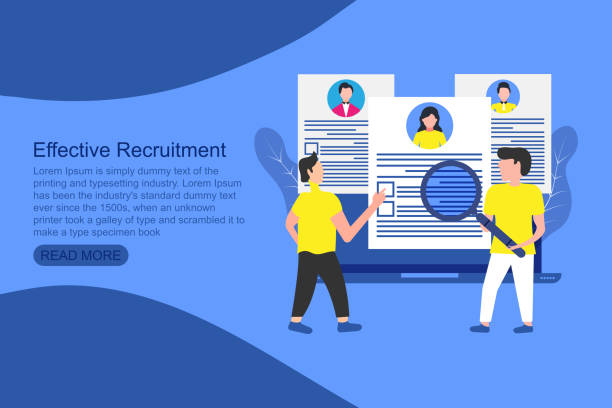
After the #multilingual_website_design phase and its launch, the work is not over.
In fact, #continuous_maintenance and #updates of a multilingual website are an ongoing and vital process to maintain its optimal performance and appeal in various markets.
Website content must be regularly updated, not only in the primary language but in all supported languages.
This includes adding new products, updating service information, publishing articles and news, and responding to frequently asked questions.
Neglecting content updates in a specific language can lead to providing outdated and incorrect information to users, which damages brand credibility.
In addition to content updates, technical website maintenance is also of great importance.
This includes CMS and plugin security updates, checking for broken links, optimizing page loading speed, and fixing any bugs or technical errors that may appear in different language versions.
Furthermore, monitoring SEO performance in each language, including tracking keyword rankings and organic traffic, is essential to ensure the site’s visibility in search engines.
Markets and linguistic preferences are constantly changing, and a successful multilingual website must be able to adapt to these changes.
Reviewing user feedback in each language and making necessary improvements based on it plays an important role in increasing customer satisfaction and longevity in international markets.
This proactive approach to maintenance keeps your website alive and competitive and ensures sustainable growth.
The Future of Multilingual Website Design and New Trends

The future of #multilingual_website_design is intertwined with #new_trends and technological advancements that are making user experiences more personalized and efficient than ever before.
One of the most important of these trends is the integration of Artificial Intelligence (AI) and Machine Learning (ML) into translation and localization processes.
Neural Machine Translation (NMT) is rapidly improving and can provide translations with near-human quality, which accelerates the translation process for large volumes of content and reduces costs.
These advancements enable the delivery of dynamic and real-time content in various languages.
Furthermore, the emergence of voice assistants and Voice Search will also impact multilingual website design.
Websites need to be optimized to respond to voice queries in different languages, which requires a deep understanding of speech patterns and conversational phrases in each language.
Personalizing the user experience based on geographical location, browsing history, and linguistic preferences will also become a standard.
This means that websites will not only provide content in the appropriate language but also tailor offers, prices, and even page layouts based on the specific user.
Augmented Reality (AR) and Virtual Reality (VR) may also play a significant role in delivering immersive multilingual experiences.
These trends indicate that multilingual website design is moving towards smarter and more integrated interactions, where linguistic and cultural boundaries will increasingly blur, painting an exciting outlook for businesses aiming for globalization.
Frequently Asked Questions
| Question | Answer |
|---|---|
| What is a multilingual website? | A website whose content is available to users in more than one language. |
| Why should I make my website multilingual? | To reach a broader audience in global markets, improve user experience, and enhance international SEO. |
| What are the technical approaches to building a multilingual website? | Using subdirectories, subdomains, or URL parameters to separate languages. |
| What impact does multilingual design have on SEO? | By targeting local keywords and providing content in users’ native languages, the website’s ranking in search engines for those regions improves. |
| What are the challenges of multilingual website design? | Content translation management, supporting right-to-left (RTL) direction, technical issues related to language addressing, and maintaining design consistency. |
| How do we choose the languages for a multilingual website? | Based on target audience analysis, desired markets, and existing website traffic data (if available). |
| What is RTL support and why is it important for some languages? | Right-to-Left, is the direction of text and page elements display from right to left, which is essential for languages like Persian, Arabic, and Hebrew. |
| How do we manage multilingual website content? | By using Content Management Systems (CMS) with multilingual capabilities, translation plugins, or professional translation services. |
| What is the user experience (UX) like on a multilingual website? | The ability to easily change languages should be provided, and the translated content should be of high quality so that users feel comfortable. |
| What are the common CMS platforms for multilingual websites? | WordPress (with plugins like WPML), Joomla, Drupal, and Shopify (with relevant settings or plugins). |
And other services of Rasaweb Advertising Agency in the field of advertising
Smart Google Ads: Professional optimization for improving SEO ranking using Google Ads management.
Smart UI/UX: A professional solution for increasing website visits with a focus on marketing automation.
Smart Marketing Automation: An innovative service for enhancing customer behavior analysis through user experience customization.
Smart Advertorial: A dedicated service for online growth based on attractive UI design.
Smart Advertorial: An innovative platform for improving website visits through marketing automation.
And over a hundred other services in the field of internet advertising, advertising consulting, and organizational solutions.
Internet Advertising | Advertising Strategy | Advertorial
Sources
Multilingual Website SEO
How to Build a Multilingual Website
Advantages of a Multilingual Website
Principles of Multilingual Website Design
? With the specialized services of “Rasaweb Afarin” Digital Marketing Agency, from secure and attractive website design to professional optimization, achieve your digital marketing goals and establish a powerful online presence.
📍 Tehran, Mirdamad Street, next to Bank Markazi, Kazeroon Jonubi Alley, Ramin Alley, No. 6


